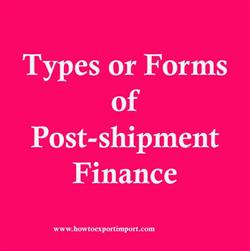Types or Forms of Post-shipment Finance:
Following special schemes are available in respect of post-shipment finance:
(a) Export Bills Negotiated under L/C: If the exporter has obtained documentary letter of credit and has submitted the required documents, as mentioned in the UC, to the bank, the bank negotiates them and sanctions the equivalent amount of post-shipment finance to the exporter, Post-shipment finance is released after liquidating the pre-shipment finance availed by the exporter.
 (b) Purchase/Discount of Export Bills: If export bills are not covered under letter of credit, the bank may extend post-shipment finance by either purchasing or discounting export bills. But before extending such finance, the bank ensures that the exporter has complied with the terms of the export contract. Such advances are generally insured by an appropriate policy of ECGC.
(b) Purchase/Discount of Export Bills: If export bills are not covered under letter of credit, the bank may extend post-shipment finance by either purchasing or discounting export bills. But before extending such finance, the bank ensures that the exporter has complied with the terms of the export contract. Such advances are generally insured by an appropriate policy of ECGC.
(c) Advance against Bills sent for Collection: Post-shipment finance can also be granted:
When the assistance available under foreign bills purchased is exhausted; or
When some export bills drawn under L/C have discrepancies; or
Where it is a customary practice in the particular line of trade.
(d) Advance against Goods sent on Consignment Basis: When goods are, exported on consignment basis export proceeds are received after sale of goods In such cases, the overseas branch of exporter’s bank delivers documents against Trust Receipt and the post-shipment advance is adjusted against export proceeds realised later.
(e) Advance against Duty Drawback: The Government of India extends certain incentives to the exporters such as the Duty Drawback (DBK), Such incentives are realised only after the shipment of goods and receipt of expects proceeds. Banks offer pre-shipment as well as post-shipment finance agars such incentives.
(f) Advance against Undrawn Balances: in certain Ines of exports, exporters do riot draw bills for the full invoice value of goads but leave a small part undrawn for adjustments on account of differences in rates, weight quality etc. Such differences can be adjusted only on the approval of the goods. Banks offer post-shipment finance against such balances.
(g) Advance against Retention Money: In the case of exports of capital goods contracts, the importer retains a part of contract price towards guarantee of performance or completion of the project. This unpaid part is known as retention money. Banks offer post-shipment finance against such money for a period of 90 days.
(h) Advance against Deferred Payments: In case of exports of capital goods or construction contracts, exporters receive a certain portion of the contract advance or down payment while the balance is received in instilments over a period of time. Banks together with the EXIM Bank otter post4hiprfleflt finance against such deferred payment.
Terms of Payment in Export and Import
Terms Used in Marine Insurance
The difference between FCA and CIP terms
The formalities to sell / auction unclaimed or un-cleared goods
The legal strength of Bill of Exchange in International Trade. What is Bill of Exchange in International Trade.
The role of bill of exchange in import export business
The role of CBEC - Central Board of Excise and Customs in India.
The role of Export Inspection Agency in Pre-shipment Inspection & Quality Control
The role of Reserve Bank of India
The Role of the International Chamber of Commerce (ICC)
The term FCL. What is FCL means
The term LCL. What does LCL mean?
Tips to exporters on Documentation
How does a Running bond work?
How does Bill of Lading work in DP payment terms?
How does Bill of Lading work in Sight LC
How does CENVAT Credit work?